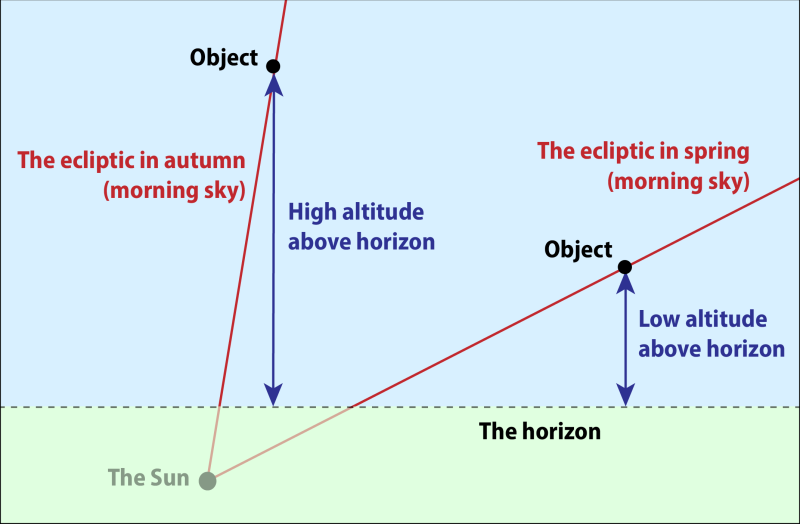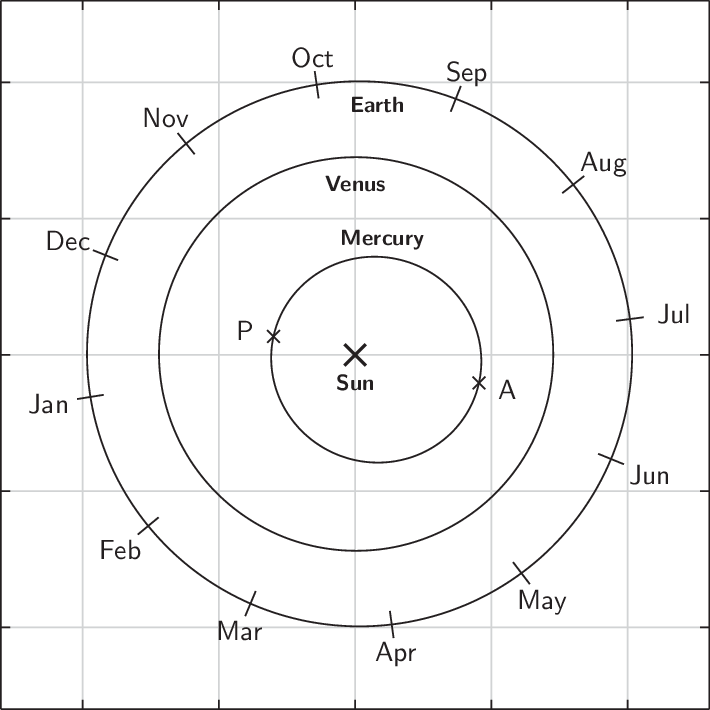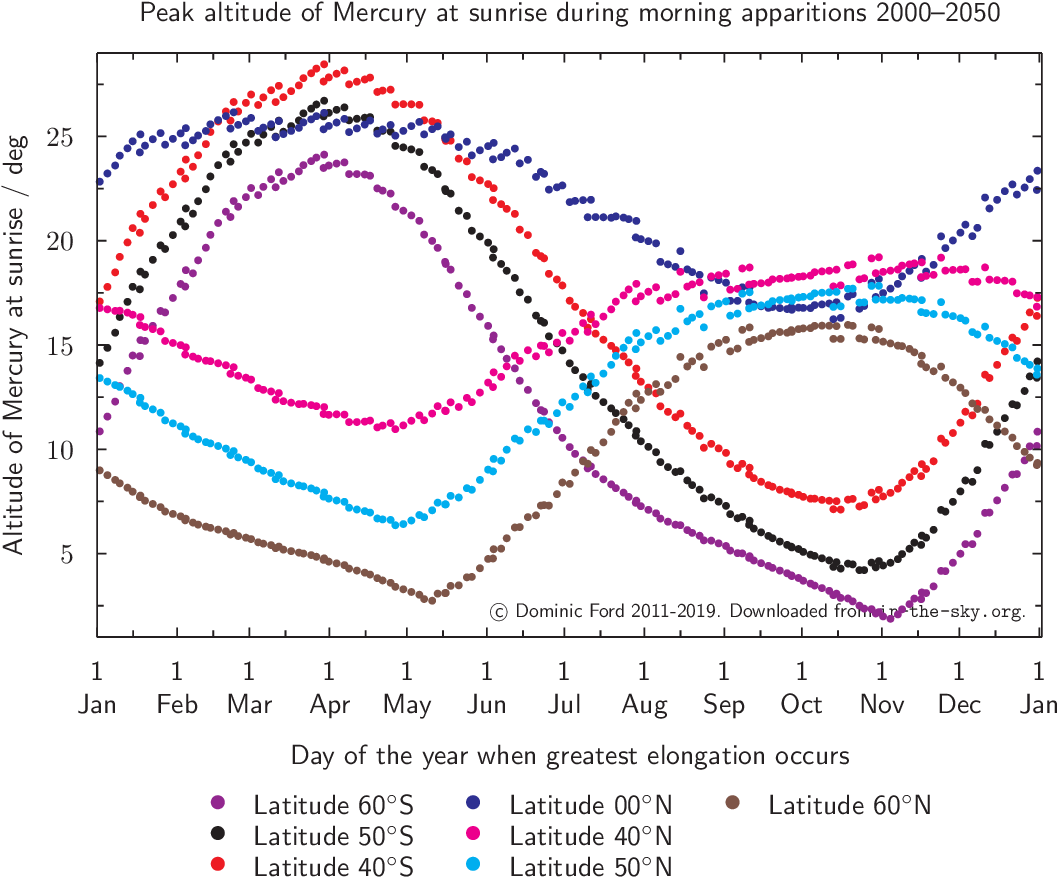As seen from South El Monte , Mercury will reach its highest point in the sky in its Mar–May 2019 morning apparition. It will be shining brightly at mag 0.3.
From South El Monte, this apparition will not be one of the most prominent and very difficult to observe, reaching a peak altitude of 12° above the horizon at sunrise on 8 Apr 2019.
Mar–May 2019 morning apparition of Mercury
| 14 Mar 2019 | – | Mercury at inferior solar conjunction |
| 07 Apr 2019 | – | Mercury at highest altitude in morning sky |
| 11 Apr 2019 | – | Mercury at greatest elongation west |
| 12 Apr 2019 | – | Mercury at dichotomy |
| 21 May 2019 | – | Mercury at superior solar conjunction |
The table below lists the altitude of Mercury at sunrise over the course of its the apparition. All times are given in South El Monte local time.
| Date | Sun rises at |
Mercury rises at |
Altitude at sunrise |
Direction at sunrise |
Mag | Phase |
| 18 Mar 2019 | 06:57 | 06:29 | 5° | east | 4.5 | 2% |
| 21 Mar 2019 | 06:53 | 06:13 | 7° | east | 3.1 | 7% |
| 24 Mar 2019 | 06:48 | 06:00 | 9° | east | 2.1 | 12% |
| 27 Mar 2019 | 06:44 | 05:49 | 11° | east | 1.5 | 19% |
| 30 Mar 2019 | 06:40 | 05:40 | 11° | east | 1.0 | 25% |
| 02 Apr 2019 | 06:36 | 05:33 | 12° | east | 0.7 | 31% |
| 05 Apr 2019 | 06:32 | 05:28 | 12° | east | 0.5 | 37% |
| 08 Apr 2019 | 06:28 | 05:24 | 12° | east | 0.4 | 42% |
| 11 Apr 2019 | 06:24 | 05:21 | 12° | east | 0.3 | 47% |
| 14 Apr 2019 | 06:20 | 05:18 | 12° | east | 0.2 | 52% |
| 17 Apr 2019 | 06:17 | 05:16 | 12° | east | 0.1 | 56% |
| 20 Apr 2019 | 06:13 | 05:15 | 11° | east | 0.0 | 60% |
| 23 Apr 2019 | 06:09 | 05:14 | 11° | east | -0.1 | 64% |
| 26 Apr 2019 | 06:06 | 05:14 | 10° | east | -0.2 | 69% |
| 29 Apr 2019 | 06:03 | 05:14 | 9° | east | -0.3 | 73% |
| 02 May 2019 | 06:00 | 05:15 | 9° | east | -0.4 | 77% |
| 05 May 2019 | 05:57 | 05:16 | 8° | east | -0.6 | 81% |
| 08 May 2019 | 05:54 | 05:18 | 6° | east | -0.8 | 86% |
| 11 May 2019 | 05:51 | 05:22 | 5° | east | -1.0 | 91% |
Mercury will brighten rapidly at the start of its morning apparition as it emerges from inferior conjunction. Prior to its apparition, it passed between the Earth and Sun, at which time it had its unilluminated side turned towards the Earth and so appeared as a thin, barely illuminated crescent. As the apparition proceeds, this crescent waxes and becomes gibbous.
Since Mercury can only ever be observed in twilight, it is particularly difficult to find when it is in a thin crescent phase. Thus, it will be significantly easier to see in the days after it reaches its highest point in the sky – when it will show a gibbous phase – than in the days beforehand.
Altitude of Mercury at sunrise
A graph of the angular separation of Mercury from the Sun around the time of greatest elongation is available here.
Apparitions of Mercury
| 06 Nov 2018 | – | Evening apparition |
| 15 Dec 2018 | – | Morning apparition |
| 26 Feb 2019 | – | Evening apparition |
| 11 Apr 2019 | – | Morning apparition |
| 23 Jun 2019 | – | Evening apparition |
| 09 Aug 2019 | – | Morning apparition |
| 19 Oct 2019 | – | Evening apparition |
Observing Mercury
Mercury's orbit lies closer to the Sun than the Earth's, meaning it always appears close to the Sun and is lost in the Sun's glare much of the time.
It is observable for only a few weeks each time it reaches greatest separation from the Sun – moments referred to as greatest elongation. These apparitions repeat roughly once every 3–4 months, taking place alternately in the morning and evening skies, depending whether Mercury lies to the east of the Sun or to the west.
When it lies to the east, it rises and sets a short time after the Sun and is visible in early evening twilight. When it lies to the west of the Sun, it rises and sets a short time before the Sun and is visible shortly before sunrise.
However, some times of the year are more favourable for viewing Mercury than others. From South El Monte, it reaches a maximum altitude of between 12° and 20° above the horizon at sunrise during each morning apparition, depending on the time of year. During its Mar–May 2019 apparition, it will peak at 12° above the horizon at sunrise on 8 Apr 2019.
This variability over the course of the year is due to a combination of two factors.
The inclination of the ecliptic to the horizon
At all times, Mercury lies close to a line across the sky called the ecliptic, which is shown in yellow in the planetarium above. This line traces the path that the Sun takes through the zodiacal constellations every year, and shows the plane of the Earth's orbit around the Sun. Since all the planets circle the Sun in almost exactly the same plane, it also closely follows the planes of the orbits of the other planets, too.
When Mercury is widely separated from the Sun, it is separated from it along the line of the ecliptic. But, at different times of year, the ecliptic meets the horizon at different angles at sunrise. This means that Mercury appears at different altitudes above the horizon at different times of year, even if its separation from the Sun is the same.
If the ecliptic meets the horizon at a shallow angle, then Mercury has to be very widely separated from the Sun to appear much above the horizon. Conversely, if the ecliptic is almost perpendicular to the horizon, Mercury may appear much higher in the sky, even if it is actually much closer to the Sun.
At sunset, the ecliptic makes its steepest angle to the horizon at the spring equinox – in March in the northern hemisphere, and in September in the southern hemisphere. Conversely, it meets the horizon at its shallowest angle at the autumn equinox. Because the seasons are opposite in the northern and southern hemispheres, a good apparition of Mercury in one hemisphere will usually be poorly placed in the other.
At sunrise, these dates are also inverted, so that for morning apparitions of Mercury, the ecliptic makes its steepest angle to the horizon at the autumn equinox, and its shallowest angle to the horizon at the spring equinox.
Mercury's elliptical orbit
A secondary effect is that Mercury is unusual among the planets for having a significantly non-circular orbit, which varies in its distance from the Sun by 52% between its closest approach (perihelion, labelled P in the diagram to the right) and greatest distance (aphelion, labelled A).
This means that Mercury's separation from the Sun at greatest elongation varies, depending where it lies relative to the aphelion or perihelion points of its orbit. In mid-September and mid-March, the Earth is well placed to view the long axis of Mercury's orbit edge-on.
So, if Mercury appears in the evening sky in mid-September, or in the morning sky in mid-March, then it appears more widely separated from the Sun than usual. Specifically, at each apparition, Mercury reaches a separation from the Sun of between 18 and 28°. During its Mar–May 2019 apparition, it will reach a maximum separation of 27° to the Sun's west at greatest elongation.
The optimum time for an apparition of Mercury
The two effects described above are of similar magnitude, though the inclination of the ecliptic to the horizon is the more significant. They conspire to make Mercury much easier to observe from the southern hemisphere than from the north.
In the southern hemisphere, apparitions of Mercury which occur when the ecliptic plane is favourably inclined to the horizon also coincide with apparitions when Mercury is close to aphelion. In the northern hemisphere, unfortunately the opposite is true: when the ecliptic plane is favourably inclined, Mercury is close to perihelion.
The plot to the right shows the maximum altitude of Mercury during all its morning apparitions between 2000 and 2050, as observed from a range of different latitudes on Earth. The highest altitudes are seen exclusively from the southern hemisphere.
Mercury's position
The position of Mercury when it reaches its highest point will be:
The coordinates above are given in J2000.0.
The sky on 7 Apr 2019
| The sky on 7 April 2019 | ||||||||||||||||||||||||||||||||||
|
10% 3 days old |
All times shown in PDT.
|
|||||||||||||||||||||||||||||||||
Source
The circumstances of this event were computed using the DE430 planetary ephemeris published by the Jet Propulsion Laboratory (JPL).
This event was automatically generated by searching the ephemeris for planetary alignments which are of interest to amateur astronomers, and the text above was generated based on an estimate of your location.
Related news
| 07 Apr 2019 | – Mercury at highest altitude in morning sky |
| 11 Apr 2019 | – Mercury at greatest elongation west |
| 18 Jun 2019 | – Mercury at highest altitude in evening sky |
| 23 Jun 2019 | – Mercury at greatest elongation east |
Image credit
© NASA/JPL/MESSENGER





